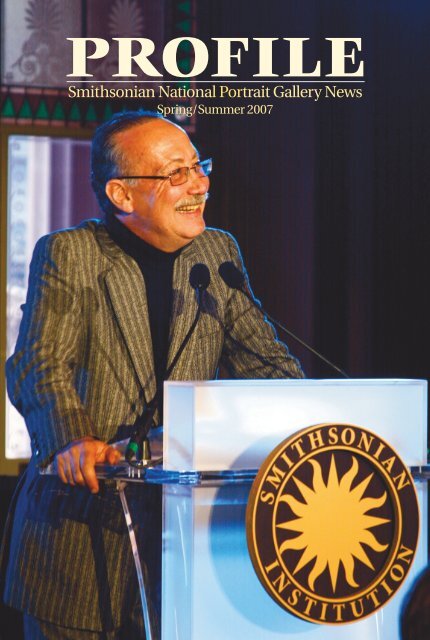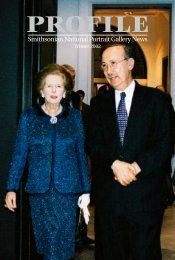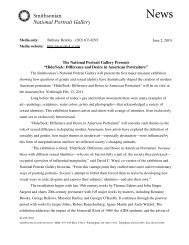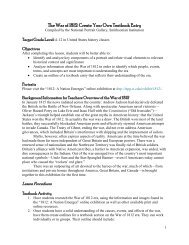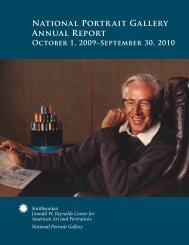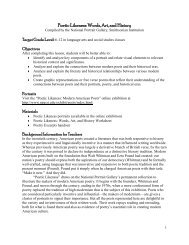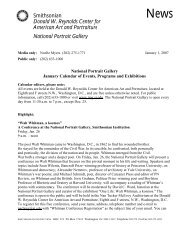Oil on cotton duck by Susan Miller-Havens (born 1944)
Oil on cotton duck by Susan Miller-Havens (born 1944)
Oil on cotton duck by Susan Miller-Havens (born 1944)
You also want an ePaper? Increase the reach of your titles
YUMPU automatically turns print PDFs into web optimized ePapers that Google loves.
PROFILE<br />
Smiths<strong>on</strong>ian Nati<strong>on</strong>al Portrait Gallery News<br />
Spring/Summer 2007
From the<br />
DIRECTOR<br />
Many things have g<strong>on</strong>e into making my Nati<strong>on</strong>al Portrait Gallery tenure<br />
an immensely rewarding experience, but chief am<strong>on</strong>g them has been the<br />
privilege of working with such an extraordinary staff. The reimagining of<br />
the Portrait Gallery would have been impossible without the commitment,<br />
energy, and intelligence that every single staff member brought to the<br />
process. We challenged each other again and again, and the result is a<br />
museum that we all can be proud of and for which we all share a profound<br />
sense of ownership. Every director dreams of experiencing the kind of<br />
community that I have been fortunate to work with here at the Portrait<br />
Gallery, and I am c<strong>on</strong>fident that whoever succeeds me will come to feel as<br />
I have about this truly remarkable group of public servants.<br />
Marc Pachter and Lilly Koltun, interim director of the Portrait Gallery of Canada, dance at the opening of the<br />
“Great Brit<strong>on</strong>s” exhibiti<strong>on</strong> in April.<br />
Cover: Marc Pachter speaks to the<br />
crowd at <strong>on</strong>e of NPG’s reopening<br />
events in June 2006. Photograph<br />
© fotobriceno<br />
© fotobriceno
PROFILE<br />
C<strong>on</strong>tents<br />
Vol. 8, nos. 1–2. Spring/Summer 2007<br />
4<br />
Marc Pachter Bids<br />
NPG Adieu<br />
6 Commissi<strong>on</strong>ing Fund<br />
Established in H<strong>on</strong>or of<br />
Marc Pachter<br />
7<br />
The Nati<strong>on</strong>al Portrait<br />
Gallery<br />
A Poem <strong>by</strong> Robert Pinsky<br />
8<br />
Historian’s Choice<br />
Carlt<strong>on</strong> Fisk<br />
9 Curator’s Choice<br />
Rachel Cars<strong>on</strong><br />
10<br />
Art Meets Chemistry<br />
and Preserves History<br />
1 Book Review<br />
Walt Disney: The Triumph<br />
of the American Imaginati<strong>on</strong><br />
<strong>by</strong> Neal Gabler<br />
1<br />
Brett Cook in<br />
Residence at<br />
Duke Ellingt<strong>on</strong><br />
School for the<br />
Arts<br />
13<br />
About Face:<br />
Seeing Yourself<br />
in NPG<br />
13<br />
“Face to Face”<br />
Bey<strong>on</strong>d the Label<br />
14<br />
NPG Exhibiti<strong>on</strong>s<br />
15<br />
NPG Outreach<br />
16<br />
Portrait Puzzlers<br />
. . . . . . . . . . . . . . . . . . . . . . . . . . . . .<br />
This issue is dedicated to the memory of graphic<br />
designer Leslie L<strong>on</strong>d<strong>on</strong>. While <strong>on</strong> staff at the Nati<strong>on</strong>al<br />
Portrait Gallery, Leslie developed the initial look of<br />
Profile. She c<strong>on</strong>tinued to design NPG’s magazine after<br />
setting out <strong>on</strong> her own. Leslie died in June after a brief<br />
illness. We will miss her enormously.<br />
. . . . . . . . . . . . . . . . . . . . . . . . . . . . .<br />
Marc Pachter Director<br />
Carolyn Carr Deputy Director and<br />
Chief Curator<br />
Editor<br />
Dru Dowdy Office of Publicati<strong>on</strong>s<br />
Associate Editor<br />
Ann M. Shumard Department of<br />
Photographs<br />
Editorial Committee<br />
Bethany Morookian Bentley<br />
Office of Development<br />
and External Affairs<br />
Lizanne Garrett Office of Photographic<br />
Services<br />
Ellen G. Miles Department of Painting<br />
and Sculpture<br />
Jewell Robins<strong>on</strong> Office of Educati<strong>on</strong><br />
David C. Ward Department of History<br />
Editorial Support<br />
Amy Baskette Curatorial Assistant<br />
George Parlier Program Assistant<br />
Caroline Wooden Graphic Designer<br />
Design<br />
Leslie L<strong>on</strong>d<strong>on</strong>, L<strong>on</strong>d<strong>on</strong> Graphics<br />
Commissi<strong>on</strong><br />
Daniel Okrent<br />
Chair<br />
Anth<strong>on</strong>y C. Beilens<strong>on</strong><br />
Vice Chair<br />
John Boochever<br />
Sally G. Chubb<br />
Jeannine Smith Clark<br />
H. P. “Pete” Claussen<br />
Joan Kent Dill<strong>on</strong><br />
Ella Milbank Foshay<br />
Michael Harreld<br />
Jill Krementz<br />
J<strong>on</strong> B. Lovelace<br />
Joan A. M<strong>on</strong>dale<br />
Robert B. Morgan<br />
Roger Mudd<br />
V. Thanh Nguyen<br />
Barbara Novak<br />
W. Dean Smith<br />
R. Ted Steinbock<br />
Mallory Walker<br />
Jack H. Wats<strong>on</strong> Jr.<br />
John Wilmerding<br />
Ex Officio Members<br />
Earl A. Powell III<br />
John G. Roberts Jr.<br />
Cristián Samper<br />
H<strong>on</strong>orary<br />
Commissi<strong>on</strong>ers<br />
Julie Harris<br />
David Levering Lewis<br />
Bette Bao Lord<br />
Fred W. Smith<br />
PROFILE<br />
Nati<strong>on</strong>al Portrait Gallery<br />
Smiths<strong>on</strong>ian Instituti<strong>on</strong><br />
750 Ninth Street, NW<br />
P.O. Box 37012, MRC 973<br />
Washingt<strong>on</strong>, DC 20013-7012<br />
Ph<strong>on</strong>e: (202) 633-8300<br />
E-mail: NPGnews@si.edu<br />
Website: www.npg.si.edu<br />
Readers’ comments are welcome. To<br />
receive Profile, please send your name,<br />
home address, and e-mail address to<br />
NPGnews@si.edu or the post office box<br />
listed above.<br />
Unless otherwise noted, all images are from<br />
the Nati<strong>on</strong>al Portrait Gallery collecti<strong>on</strong>.<br />
©2007 Smiths<strong>on</strong>ian Instituti<strong>on</strong>. All rights reserved.
Marc Pachter Bids NPG Adieu<br />
David C. Ward<br />
Historian & Deputy Editor,<br />
Peale Family Papers<br />
“I view my life in chapters, and it is time for me to<br />
begin to write a new <strong>on</strong>e.” With these words, Marc<br />
Pachter announced his retirement from the Smiths<strong>on</strong>ian<br />
Instituti<strong>on</strong> after more than thirty years of<br />
a career that has been intertwined with the history<br />
of the Nati<strong>on</strong>al Portrait Gallery. Looking<br />
backward, Pachter feels tremendously fortunate<br />
to have “fallen into” the Smiths<strong>on</strong>ian, since it provided<br />
him with the venue for both thinking about<br />
and “doing” public culture. Just out of graduate<br />
school, he began his career in 1974 as NPG’s chief<br />
historian and, showing bureaucratic and collegial<br />
skills rare for an academic, rose through the Smiths<strong>on</strong>ian’s<br />
ranks to close his career <strong>by</strong> serving as the<br />
Portrait Gallery’s director (2000–2007). In that<br />
positi<strong>on</strong>, he headed the Gallery during the years<br />
in which the Patent Office Building was closed for<br />
renovati<strong>on</strong>, a period in which he kept the Gallery’s<br />
missi<strong>on</strong> alive <strong>by</strong> insisting that “while the building<br />
is closed, the museum is still open.” Signal<br />
achievements of his tenure were obtaining funding<br />
from the D<strong>on</strong>ald W. Reynolds Foundati<strong>on</strong> to<br />
purchase Gilbert Stuart’s “Lansdowne” portrait<br />
of George Washingt<strong>on</strong>, maintaining a vigorous<br />
traveling exhibiti<strong>on</strong> program, and reorganizing the<br />
Portrait Gallery, as evidenced both visually and<br />
c<strong>on</strong>ceptually in its stunning renovated quarters in<br />
what is now known as the D<strong>on</strong>ald W. Reynolds<br />
Center for American Art and Portraiture. Am<strong>on</strong>g<br />
his other innovati<strong>on</strong>s, Pachter promoted the “One<br />
Life” exhibiti<strong>on</strong> space, in which a curator would be<br />
given a free hand to offer a new take <strong>on</strong> a selected<br />
pers<strong>on</strong>. Pachter will leave NPG after having champi<strong>on</strong>ed<br />
the exhibiti<strong>on</strong> “Great Brit<strong>on</strong>s: Treasures<br />
from the Nati<strong>on</strong>al Portrait Gallery, L<strong>on</strong>d<strong>on</strong>,” in<br />
h<strong>on</strong>or of the first nati<strong>on</strong>al portrait gallery. The<br />
opening was attended <strong>by</strong> portrait gallery directors<br />
from around the world.<br />
As he prepares to retire, Pachter sat in his<br />
creatively disheveled office and answered some<br />
questi<strong>on</strong>s both about himself and the place of the<br />
Nati<strong>on</strong>al Portrait Gallery in American culture.<br />
Pachter is famous am<strong>on</strong>g the staff for refusing to<br />
admit that there were problems, <strong>on</strong>ly “challenges<br />
that have yet to be surmounted.” In particular, as<br />
a cultural historian, Pachter always insisted to both<br />
the staff and the public that the Gallery must widen<br />
the variety of modes of portrayal that it uses to depict<br />
estimable lives; indeed, while Pachter is cognizant,<br />
and appreciative of, the visual traditi<strong>on</strong> of portraiture,<br />
he believes that the Gallery should be renamed<br />
the “Nati<strong>on</strong>al Portrayal Gallery” to better exem-<br />
4 Marc Pachter Bids NPG Adieu<br />
Marc Pachter sits for his portrait <strong>by</strong> Robert Liberace<br />
in <strong>on</strong>e of NPG’s galleries.<br />
plify the full range of methods—from oil painting<br />
to biography to artistic performances—that it uses<br />
to bring historic subjects to life. An unabashed technophile,<br />
Pachter is a fervent advocate of developing<br />
and using new informati<strong>on</strong> delivery systems—from<br />
handheld computers to holographic imagery—to<br />
broaden and deepen the visual and textual informati<strong>on</strong><br />
that can be imparted to the Gallery’s visitors.<br />
As a student of biography and the intersecti<strong>on</strong><br />
of the individual with culture, Pachter is an<br />
unabashed democrat and a populist (in the good<br />
sense!), a firm believer in the individual and the<br />
society’s capacity for creative curiosity. “I would<br />
have been involved in the c<strong>on</strong>versati<strong>on</strong> about public<br />
culture regardless of my career, but the advantage<br />
of being at the Portrait Gallery is that you are in a<br />
direct c<strong>on</strong>versati<strong>on</strong> with the American people about<br />
their heritage.” When asked whether the Smiths<strong>on</strong>ian<br />
“trusts” its audience, he resp<strong>on</strong>ds with a firm<br />
“Yes,” but with a wry acknowledgement that work<br />
needs to be d<strong>on</strong>e to break down the hierarchies and<br />
categories of academic life. “I’m absolutely optimistic<br />
about public culture in America. We have proven<br />
at the Smiths<strong>on</strong>ian that democracy is compatible<br />
with the highest aspirati<strong>on</strong>s of culture. I never worry<br />
that democracy degrades culture; I never worry that<br />
popularity is a problem. What I worry about is that<br />
people will be narrow in their appreciati<strong>on</strong> of what<br />
culture represents. Quality is not a c<strong>on</strong>siderati<strong>on</strong><br />
foreign to democracy.” So while retaining the Gallery’s<br />
traditi<strong>on</strong>al missi<strong>on</strong>, Pachter has overseen the<br />
broadening of the definiti<strong>on</strong> of who has c<strong>on</strong>tributed<br />
to the history of America. One of Pachter’s<br />
accomplishments as director was to eliminate the<br />
“ten-years dead” rule for admissi<strong>on</strong> to the permanent<br />
collecti<strong>on</strong>, which there<strong>by</strong> gives a more c<strong>on</strong>temporary<br />
feel to the Gallery’s assemblage of worthies.<br />
And in the Gallery’s exhibiti<strong>on</strong> spaces, modern<br />
means of portrayal, including video portraits, are<br />
Sherri Weil
explored al<strong>on</strong>gside likenesses in more traditi<strong>on</strong>al<br />
media. Pachter’s favorite word is “c<strong>on</strong>versati<strong>on</strong>” to<br />
describe how the museum interacts with the public.<br />
“We need to tap into all the arts; this is not just a<br />
museum of visual culture. The c<strong>on</strong>cept of portrayal<br />
needs to broaden through the arts, and through that<br />
I hope we can engage the public in a c<strong>on</strong>versati<strong>on</strong><br />
about what greatness means.”<br />
When asked whether he had ever expected to<br />
be named director of the Nati<strong>on</strong>al Portrait Gallery,<br />
Pachter resp<strong>on</strong>ded that he hadn’t focused his career<br />
<strong>on</strong> gaining the directorship but that his l<strong>on</strong>g-held<br />
affecti<strong>on</strong> for the Gallery and its missi<strong>on</strong> made him<br />
accept the job when it was offered. He thought that<br />
the Gallery’s viability was at stake and that his skill<br />
set and experiences, both academic and pers<strong>on</strong>al,<br />
would be useful. Pachter finds it ir<strong>on</strong>ic that he, “who<br />
was a child of the sixties,” would have developed an<br />
appreciati<strong>on</strong> for bureaucracy over the course of his<br />
career: “Sure, bureaucracy can be maddening, but<br />
you grow to respect it, and learn to operate within<br />
it, because it’s <strong>on</strong>ly through it—and organizati<strong>on</strong>al<br />
memory—that you can keep valuable, complex instituti<strong>on</strong>s<br />
alive and flourishing. The problem happens<br />
when bureaucracy becomes the point of an instituti<strong>on</strong><br />
rather than a means to achieve its higher goals.”<br />
“The Nati<strong>on</strong>al Portrait Gallery treasures its<br />
aut<strong>on</strong>omy within the family of the Smiths<strong>on</strong>ian<br />
and treasures, too, its associati<strong>on</strong> with portrait<br />
galleries around the world. We share a missi<strong>on</strong><br />
to present history through the arts. I hope nothing<br />
will compromise that independent missi<strong>on</strong> in<br />
the future.” Having steered the NPG through <strong>on</strong>e<br />
remaking, Marc Pachter has a bittersweet sense of<br />
awareness that it will be up to a new director to<br />
write the next chapter in the Gallery’s history.<br />
At the invitati<strong>on</strong> of Marc Pachter, directors of<br />
portrait galleries throughout the world c<strong>on</strong>vened in<br />
Washingt<strong>on</strong> in April. Pictured with Pachter are (left<br />
to right): Andrew Sayers (Australia), Lilly Koltun<br />
(Canada), Pachter, Avenal McKinn<strong>on</strong> (New Zealand),<br />
and Sandy Nairne (Great Britain).<br />
Mark Gulezian<br />
Marc’s Favorites:<br />
Hero: Abraham Lincoln<br />
Motto:<br />
Living well is the best revenge<br />
Favorite food: Fresh apricots<br />
Favorite place<br />
I’d like to be right now:<br />
Sydney, Australia, at the Art<br />
House Hotel<br />
Best meal I ever had:<br />
Sixtieth birthday party: roast<br />
suckling pig with family and<br />
friends in a grand L<strong>on</strong>d<strong>on</strong><br />
restaurant<br />
Favorite portrait:<br />
Thomas Eakins’s painting of<br />
Walt Whitman (Pennsylvania<br />
Academy of the Fine Arts)<br />
Favorite album:<br />
Sergeant Pepper’s L<strong>on</strong>ely<br />
Hearts Club Band<br />
Favorite movie: Everything Is<br />
Illuminated<br />
Favorite play: A Streetcar<br />
Named Desire<br />
Favorite actor: Derek Jacobi<br />
Favorite TV program:<br />
Family (ABC, <strong>by</strong> Mike Nichols)<br />
Favorite book:<br />
David Copperfield <strong>by</strong> Charles<br />
Dickens<br />
Favorite historic period:<br />
1880–1914— the era of<br />
cosmopolitanism<br />
Most influenced <strong>by</strong>: Novels<br />
of Henry James<br />
Secret vice: “Well then it<br />
wouldn’t be secret, would it<br />
now?”<br />
Least favorite trait:<br />
Deviousness<br />
Favorite trait:<br />
Trustworthiness<br />
Achievement: Saving the<br />
“Lansdowne” portait of George<br />
Washingt<strong>on</strong> for the NPG and<br />
the nati<strong>on</strong><br />
Marc Pachter Bids NPG Adieu 5
Commissi<strong>on</strong>ing Fund Established in H<strong>on</strong>or<br />
of Marc Pachter<br />
The Nati<strong>on</strong>al Portrait Gallery is pleased to<br />
announce a new initiative to expand and enhance<br />
its collecti<strong>on</strong> with the establishment of the Marc<br />
Pachter Fund for commissi<strong>on</strong>ing portraits. Appropriately<br />
named in h<strong>on</strong>or of the Gallery’s retiring<br />
director, whose visi<strong>on</strong> has broadened our overall<br />
collecting efforts, the fund will provide NPG with<br />
a new opportunity to commissi<strong>on</strong> portraits of<br />
living subjects for our permanent collecti<strong>on</strong>.<br />
The Gallery celebrates the lives of individuals<br />
who have made a difference in our nati<strong>on</strong>’s history.<br />
The works in our collecti<strong>on</strong> not <strong>on</strong>ly speak to a subject’s<br />
particular achievements but also help us tell his<br />
or her story. Poets and presidents, visi<strong>on</strong>aries and<br />
villains, actors and activists — all enter the Gallery<br />
through generous d<strong>on</strong>ati<strong>on</strong>s, judicious purchases,<br />
or, in the future, commissi<strong>on</strong>s. During his tenure<br />
as director, Marc Pachter has had a str<strong>on</strong>g desire<br />
to establish a commissi<strong>on</strong>ing process and expand<br />
NPG’s definiti<strong>on</strong> of portraiture from the traditi<strong>on</strong>al<br />
media—painting, sculpture, prints, drawings, and<br />
photography—to include such new media as video,<br />
as well as the performing arts. Pachter has often<br />
talked about the Gallery as a “dinner party with<br />
history” that showcases all the ways in which lives<br />
are portrayed.<br />
The Outwin Boochever Portrait Competiti<strong>on</strong><br />
has provided <strong>on</strong>e vehicle for commissi<strong>on</strong>s:<br />
the winner of the triennial competiti<strong>on</strong> receives a<br />
commissi<strong>on</strong> to create a portrait for the Gallery’s<br />
permanent collecti<strong>on</strong>. The first such work, <strong>by</strong><br />
2006 OPBC winner David Lenz, is expected to be<br />
unveiled in 2008.<br />
Pachter’s visi<strong>on</strong> is to build up<strong>on</strong> NPG’s current<br />
efforts <strong>by</strong> making it possible to annually commissi<strong>on</strong><br />
other portraits of individuals. This will enable<br />
us to expand our representati<strong>on</strong> of c<strong>on</strong>temporary<br />
leaders in a variety of fields. For example, the Gallery<br />
has found it difficult, for various reas<strong>on</strong>s, to<br />
locate images of certain types of subjects, including<br />
scientists, envir<strong>on</strong>mentalists, educators, and<br />
business leaders. Commissi<strong>on</strong>ing will allow us to<br />
address those gaps. But it also presents an exciting<br />
opportunity to broaden the collecti<strong>on</strong> <strong>by</strong> presenting<br />
the work of younger artists and increasing our<br />
range of media. It is the creati<strong>on</strong> of the Pachter<br />
fund that allows this to happen.<br />
The commissi<strong>on</strong>ing process is always a balancing<br />
act between artist and sitter. Matching an individual<br />
with a suitable artist—the most important<br />
part of the process—takes time. By experimenting<br />
with new media, such as video, encouraging young<br />
artists, or approaching more established artists<br />
6 Commissi<strong>on</strong>ing Fund<br />
Alexander Raho’s 2004 portrait of Judi Dench is the<br />
result of a commissi<strong>on</strong> <strong>by</strong> the British Nati<strong>on</strong>al Portrait<br />
Gallery.<br />
who may not normally undertake portrait commissi<strong>on</strong>s,<br />
new and exciting projects can be <strong>born</strong>. Commissi<strong>on</strong>ing<br />
portraits brings vitality to the collecti<strong>on</strong><br />
and also helps ensure that portraiture remains a<br />
vital force in c<strong>on</strong>temporary art.<br />
We have learned from our sister instituti<strong>on</strong> in<br />
L<strong>on</strong>d<strong>on</strong> how successful this process can be. Our<br />
current exhibiti<strong>on</strong>, “Great Brit<strong>on</strong>s: Treasures from<br />
the Nati<strong>on</strong>al Portrait Gallery, L<strong>on</strong>d<strong>on</strong>,” includes<br />
a number of important examples from the British<br />
Portrait Gallery’s own commissi<strong>on</strong>ing program—now<br />
in place for more than twenty-five<br />
years. “Great Brit<strong>on</strong>s” includes portraits of Salman<br />
Rushdie, Sir Ian McKellan, Thomas Ades, Dame<br />
Judi Dench, and David Beckham. Artist Alexander<br />
Raho, for example, has captured Dench in a<br />
way that allows the viewer to imagine her in any<br />
role. She is portrayed in everyday clothes, and the<br />
subtlety and simplicity of her full-length portrait<br />
has an immense visual effect.<br />
Establishing this new fund will h<strong>on</strong>or Marc<br />
Pachter’s visi<strong>on</strong> of the Nati<strong>on</strong>al Portrait Gallery.<br />
If you would like to learn more about the<br />
Marc Pachter Fund, please c<strong>on</strong>tact Sherri Weil at<br />
weils@si.edu or (202) 633-8297.<br />
© Nati<strong>on</strong>al Portrait Gallery, L<strong>on</strong>d<strong>on</strong>
The Nati<strong>on</strong>al Portrait Gallery<br />
A Poem <strong>by</strong> Robert Pinsky<br />
Robert Pinsky, three-time poet laureate of the<br />
United States and author of many books, including<br />
The Figured Wheel, was commissi<strong>on</strong>ed to write<br />
a poem celebrating the history and reopening of<br />
the Nati<strong>on</strong>al Portrait Gallery in July 2006. The<br />
In every face some trace of the enigma that causes<br />
Foliage brief atop the l<strong>on</strong>g rootstalk that plunges<br />
Straight down through the tangled, mineral dark.<br />
(Who was the wounded soldier, who was the nurse?)<br />
In any tenement or tower, that same underforce:<br />
The spaces and uses vary, as the visible withers but<br />
The frame keeps rigid, the foundati<strong>on</strong> reaches for bedrock.<br />
(Who were the waltzers, what was the cause?)<br />
Implicit in every portrait the c<strong>on</strong>cealed, vertical taproot<br />
Suckles the beauty or ingenuity, the exploits and devisings<br />
Of war or statecraft, tributes and poses—Walt Whitman<br />
(What was the wound, what was in the glass cases?)<br />
Photographed with a fake butterfly alit <strong>on</strong> his knuckle:<br />
His token of natural harm<strong>on</strong>y c<strong>on</strong>trived, with purposeful<br />
Industry like a caterpillar’s, from painted cardboard.<br />
(What was the place, what was it for?)<br />
The Uni<strong>on</strong> soldier was D. F. Russell, shot in the bladder.<br />
The nurse Whitman was more of a social worker.<br />
The place was the old Patent Office Building—<br />
An improvised military hospital and morgue, the cots<br />
Am<strong>on</strong>g glass cases holding thousands of miniature<br />
Models of inventi<strong>on</strong>s. In the same hall hundreds waltzed<br />
At the sec<strong>on</strong>d inaugural ball of Abraham Lincoln.<br />
The models, mahogany and brass, were lost in a fire.<br />
Blood from the lash paid for <strong>by</strong> blood from the sword.<br />
Gallery of inventors, soldiers, dancers, slaveholders,<br />
Slaves, all stepping into the jaws of memory—and To thee<br />
Old cause! he wrote, Thou peerless, Passi<strong>on</strong>ate<br />
Good cause, Thou stern remorseless, sweet<br />
Idea, Deathless throughout the ages, races, lands<br />
. . . I think all war through time was really fought,<br />
And ever will be really fought, for thee.<br />
poem has also been published as a fine art, limited<br />
editi<strong>on</strong> broadside. The poem and the broadside<br />
were underwritten <strong>by</strong> a grant from the Reva and<br />
David Logan Foundati<strong>on</strong>. For further informati<strong>on</strong>,<br />
c<strong>on</strong>tact David C. Ward at WardD@si.edu.<br />
7
HISTORIAN’S CHOICE Carlt<strong>on</strong> Fisk<br />
<str<strong>on</strong>g>Oil</str<strong>on</strong>g> <strong>on</strong> cott<strong>on</strong> <strong>duck</strong> <strong>by</strong> <strong>Susan</strong> <strong>Miller</strong>-<strong>Havens</strong> (<strong>born</strong> <strong>1944</strong>), 1993,<br />
gift of Peter C. Aldrich, in memory of Duane C. Aldrich of Atlanta, Georgia<br />
Sidney Hart<br />
Senior Historian and Editor,<br />
Peale Family Papers<br />
A prominent baseball expert has ranked Hall-of-<br />
Fame catcher Carlt<strong>on</strong> Fisk (<strong>born</strong> 1947) as the sixthgreatest<br />
major-league catcher of all time, behind <strong>on</strong>ly<br />
Yogi Berra, Johnny Bench, Roy Campanella, Mickey<br />
Cochrane, and Mike Piazza.<br />
Fisk’s offensive statistics and<br />
his l<strong>on</strong>gevity are remarkable.<br />
He holds the record for the<br />
number of games played as<br />
a catcher (2,226), and is sec<strong>on</strong>d<br />
<strong>on</strong>ly to Piazza in home<br />
runs hit as a catcher (351).<br />
A major leaguer for twentyfour<br />
seas<strong>on</strong>s—first with the<br />
Bost<strong>on</strong> Red Sox, then with<br />
the Chicago White Sox—Fisk<br />
made the All-Star team eleven<br />
times. In 1972, he was the<br />
first player to be unanimously<br />
chosen Rookie of the Year, a<br />
year in which he w<strong>on</strong> a Gold<br />
Glove and was tied for the<br />
lead in triples (9), the last<br />
time a catcher led the league<br />
in that category. Fisk hit seventy-two<br />
home runs after the<br />
age of forty, a major-league<br />
record, and in 1991, at the<br />
age of forty-three, he was the<br />
oldest player to get a hit in<br />
the All-Star game. Fisk hit<br />
twenty or more home runs in<br />
eight seas<strong>on</strong>s, with a career<br />
high of thirty-seven in 1985.<br />
Although statistics are important in baseball,<br />
Fisk is much more than the sum of his numbers.<br />
The catcher’s positi<strong>on</strong> in baseball is physically the<br />
most demanding, but Fisk’s l<strong>on</strong>gevity and his ability<br />
to come back from serious injury mark him as<br />
a tough guy even am<strong>on</strong>g catchers. He played the<br />
game hard, demanded a lot from his teammates,<br />
and even expected the oppositi<strong>on</strong> to play the game<br />
the right way. In <strong>on</strong>e memorable episode, Yankee<br />
player Dei<strong>on</strong> Sanders, a talented football player<br />
who thought he could play baseball, hit a pop fly<br />
and, with Fisk yelling at him to run it out, refused<br />
to run to first base. When Sanders next came to bat,<br />
Fisk angrily told him, loud enough to be heard <strong>on</strong><br />
the Yankee bench, “If you d<strong>on</strong>’t play it [the game]<br />
right, I’m going to kick your ass right here in Yankee<br />
8 Historian’s Choice<br />
Stadium.” The shocked Sanders later apologized.<br />
There is <strong>on</strong>e game, however, which many fans<br />
c<strong>on</strong>sider the defining moment in Fisk’s career: game<br />
six of the 1975 World Series between the Cincinnati<br />
Reds and the Bost<strong>on</strong> Red Sox. The Sox were<br />
a very str<strong>on</strong>g team that year, and the “Red Sox<br />
Nati<strong>on</strong>” was hopeful that the “curse”—allegedly<br />
dooming Bost<strong>on</strong> in World Series<br />
competiti<strong>on</strong> after it sold<br />
Babe Ruth to the Yankees in<br />
1919—would be broken. But<br />
Cincinnati had its “Big Red<br />
Machine,” boasting <strong>on</strong>e of<br />
the most powerful batting<br />
lineups in baseball history. In<br />
the eighth inning of game six,<br />
the Reds, with a 3–2 game<br />
advantage in the series, had<br />
a 6–3 lead, but the Sox tied<br />
the game up with a threerun<br />
pinch-hit homer in the<br />
bottom of the inning. In the<br />
ninth, the Sox had the bases<br />
loaded and no outs. They<br />
failed to score, however, and<br />
the game went into extra<br />
innings. Only a spectacular<br />
catch <strong>by</strong> Bost<strong>on</strong> outfielder<br />
Dwight Evans prevented<br />
Cincinnati from scoring in<br />
the top of the eleventh. At<br />
12:33 a.m., Fisk led off in the<br />
bottom of the twelfth and<br />
blasted a ball high and deep<br />
down the left-field line. It<br />
was unquesti<strong>on</strong>ably a home<br />
run, if it stayed fair. All those in Fenway Park and<br />
watching <strong>on</strong> TV will never forget Fisk at home plate,<br />
jumping wildly up and down, frantically waving the<br />
ball to the right side of the foul pole, using all his<br />
body language and willpower to direct the ball fair.<br />
Mind may have triumphed over matter, because the<br />
ball hit the foul pole for a game-winning home run.<br />
The “curse” would hold, as the Reds went <strong>on</strong> to take<br />
game seven and the series, but Fisk expressed it best:<br />
“The Red Sox w<strong>on</strong> that series, 3 games to 4.”<br />
<strong>Susan</strong> <strong>Miller</strong>-<strong>Havens</strong>, who works out of Cambridge,<br />
Massachusetts, specializes in sports figures,<br />
and painted this portrait and three others of Fisk<br />
from video sources.<br />
© <strong>Susan</strong> <strong>Miller</strong>-<strong>Havens</strong><br />
For further reading: Bill James, The New Bill James Historical<br />
Baseball Abstract (New York: Free Press, 2003).
CURATOR’S CHOICE Rachel Cars<strong>on</strong><br />
Gelatin silver print <strong>by</strong> Alfred Eisenstaedt, 1962<br />
Frank H. Goodyear III<br />
Assistant Curator of Photographs<br />
In a 1962 Life magazine profile of Rachel Cars<strong>on</strong><br />
(1907–1964), the former government biologist<br />
claimed “no wish to start a Carrie Nati<strong>on</strong><br />
crusade” with the publicati<strong>on</strong> of her new book,<br />
Silent Spring. A private and soft-spoken individual,<br />
Cars<strong>on</strong> possessed a temperament<br />
wholly different than<br />
that of the famous hatchetwielding<br />
temperance leader.<br />
Yet in envisi<strong>on</strong>ing a future<br />
where the sounds of spring<br />
are absent, Silent Spring<br />
provoked a heated c<strong>on</strong>troversy<br />
about the unrestricted<br />
use of chemical pesticides.<br />
Her writings—and later<br />
c<strong>on</strong>gressi<strong>on</strong>al testim<strong>on</strong>y—<br />
would lead not <strong>on</strong>ly to the<br />
banning of DDT and other<br />
pois<strong>on</strong>ous agents, but would<br />
precipitate broad changes<br />
in the public’s understanding<br />
of and appreciati<strong>on</strong> for<br />
the delicate relati<strong>on</strong>ship<br />
between mankind and the<br />
natural envir<strong>on</strong>ment.<br />
Alfred Eisenstaedt’s<br />
portrait—published al<strong>on</strong>gside Cars<strong>on</strong>’s Life profile<br />
and recently acquired <strong>by</strong> the Nati<strong>on</strong>al Portrait<br />
Gallery—shows the fifty-five-year-old Cars<strong>on</strong><br />
behind a microscope at her Silver Spring, Maryland,<br />
home. Although it was her lyricism as a<br />
writer that made her books nati<strong>on</strong>al best-sellers,<br />
Cars<strong>on</strong> was always proud of her work as a scientist.<br />
In 1936, when she accepted her first fulltime<br />
job, as a marine biologist at the U.S. Fish<br />
and Wildlife Service, she was <strong>on</strong>e of <strong>on</strong>ly two<br />
female professi<strong>on</strong>als at the agency. Throughout<br />
her career, Cars<strong>on</strong> remained dedicated to field<br />
research and ever curious about the natural world<br />
around her.<br />
Although she was an acclaimed writer before<br />
the publicati<strong>on</strong> of Silent Spring, having w<strong>on</strong> a<br />
Nati<strong>on</strong>al Book Award in 1951 for The Sea Around<br />
Us, it was her investigati<strong>on</strong> into the harm of manmade<br />
pollutants in Silent Spring that placed her at<br />
the center of a nati<strong>on</strong>al battle between the chemical<br />
industry and a growing legi<strong>on</strong> of envir<strong>on</strong>mental<br />
supporters. Likening the effects of pesticides<br />
to those of atomic radiati<strong>on</strong>, she stated, “I wrote<br />
the book because I think there is a great danger<br />
that the next generati<strong>on</strong> will have no chance to<br />
know nature as we do—if we d<strong>on</strong>’t preserve it the<br />
damage will be irreversible.”<br />
Adversaries so<strong>on</strong> lined up to c<strong>on</strong>test her findings.<br />
Despite fifty-five pages of scientific endnotes,<br />
many characterized her as<br />
a “hysterical woman” and<br />
accused her of lacking scientific<br />
credentials; a former<br />
Department of Agriculture<br />
secretary even labeled her a<br />
Communist. Yet President<br />
John F. Kennedy took notice<br />
and called for a further<br />
investigati<strong>on</strong> of the issues the<br />
book raised. Before a Senate<br />
subcommittee, Cars<strong>on</strong> reiterated<br />
that envir<strong>on</strong>mental<br />
polluti<strong>on</strong> is <strong>on</strong>e of the “major<br />
problems of modern life.” A<br />
subsequent special report<br />
c<strong>on</strong>firmed her findings and<br />
helped pave the way for dramatic<br />
changes in the use of<br />
pesticides. DDT—developed<br />
during World War II<br />
and widely used in domestic<br />
agriculture—was eventually banned in the United<br />
States, in 1972.<br />
“It’s always so easy to assume that some<strong>on</strong>e<br />
else is taking care of things,” Cars<strong>on</strong> reflected<br />
about her experience. “People say, ‘We wouldn’t<br />
be allowed to use these things if they were dangerous.’<br />
It just isn’t so. Trusting so-called authority<br />
is not enough. A sense of pers<strong>on</strong>al resp<strong>on</strong>sibility<br />
is what we desperately need.” While Cars<strong>on</strong><br />
never anticipated becoming a nati<strong>on</strong>ally renowned<br />
figure, her search for truth highlighted the ecological<br />
impact of new technologies and provoked<br />
others to acti<strong>on</strong>. Tragically, Cars<strong>on</strong> died of breast<br />
cancer <strong>on</strong>ly eighteen m<strong>on</strong>ths after Silent Spring’s<br />
publicati<strong>on</strong>. As this year marks the <strong>on</strong>e-hundredth<br />
anniversary of her birth, the Nati<strong>on</strong>al Portrait<br />
Gallery salutes her remarkable c<strong>on</strong>tributi<strong>on</strong>s to<br />
the envir<strong>on</strong>mental movement that she so modestly<br />
helped to nurture.<br />
For further reading: Linda Lear, Rachel Cars<strong>on</strong>: Witness<br />
for Nature (New York: Henry Holt, 1997)<br />
Curator’s Choice 9
Art Meets Chemistry and Preserves History<br />
Julie Heath<br />
Lunder C<strong>on</strong>servati<strong>on</strong> Center<br />
Programs Coordinator<br />
“When an art c<strong>on</strong>servator tries to make her work<br />
invisible to the museum visitor—but identifiable<br />
to other c<strong>on</strong>servators—how does she decide what<br />
materials to use?” This was just <strong>on</strong>e of the thoughtprovoking<br />
questi<strong>on</strong>s asked <strong>by</strong> a sophomore from<br />
Thomas Jeffers<strong>on</strong> High School for Science and<br />
Technology in Fairfax County, Virginia, during<br />
a recent visit to the Lunder C<strong>on</strong>servati<strong>on</strong> Center<br />
in the D<strong>on</strong>ald W. Reynolds Center for American<br />
Art and Portraiture. Nineteen students, most from<br />
an advanced placement chemistry course, participated<br />
in a cross-disciplinary program <strong>on</strong> March<br />
27 in which they visited the shared c<strong>on</strong>servati<strong>on</strong><br />
laboratories of the Nati<strong>on</strong>al Portrait Gallery and<br />
the Smiths<strong>on</strong>ian American Art Museum.<br />
The c<strong>on</strong>servati<strong>on</strong> staff encouraged students to<br />
c<strong>on</strong>sider the ethics of art c<strong>on</strong>servati<strong>on</strong> while dem<strong>on</strong>strating<br />
techniques used for examining artwork.<br />
After d<strong>on</strong>ning safety goggles, <strong>on</strong>e group looked<br />
<strong>on</strong> as paintings c<strong>on</strong>servator Lou Molnar darkened<br />
the room and directed two ultraviolet lamps<br />
toward a portrait of a young woman. Areas of<br />
inpaint, imperceptible in ambient light, absorbed<br />
ultraviolet radiati<strong>on</strong> and appeared as dark spots<br />
under UV. The c<strong>on</strong>servators explained to the students<br />
that the paint chosen <strong>by</strong> the c<strong>on</strong>servator<br />
for the inpainting treatment fluoresces differently<br />
from the artist’s material so future c<strong>on</strong>servators<br />
will be able to readily distinguish the c<strong>on</strong>servator’s<br />
work from that of the artist. The c<strong>on</strong>servator’s<br />
medium was also chosen for its ease of removal,<br />
a c<strong>on</strong>servati<strong>on</strong> c<strong>on</strong>cept known as “reversability.”<br />
Other examinati<strong>on</strong> techniques—including the use<br />
of raking light, infrared light, and X-radiography—filled<br />
the remaining thirty-minute visit to<br />
the Paintings Lab. Before moving <strong>on</strong>, <strong>on</strong>e student<br />
lingered, seemingly transfixed <strong>by</strong> the X-ray film<br />
revealing painted layers beneath a Matthew Pratt<br />
portrait.<br />
The Thomas Jeffers<strong>on</strong>–Lunder program resulted<br />
from seven m<strong>on</strong>ths of planning between the Lunder<br />
staff and two enthusiastic educators. Milde Waterfall,<br />
a humanities teacher, and Kendal Orenstein,<br />
a chemistry teacher, saw in art c<strong>on</strong>servati<strong>on</strong> an<br />
opportunity to teach about the intersecti<strong>on</strong> of art<br />
and science. Each identified c<strong>on</strong>cepts that students<br />
should take away from the experience. Waterfall<br />
wanted students to see how c<strong>on</strong>servators formulated<br />
questi<strong>on</strong>s as a means of problem-solving. Orenstein<br />
wanted the students to witness applied chemistry in<br />
the arts. As part of the preparati<strong>on</strong>, they scheduled<br />
10 Art Meets Chemistry<br />
NPG paper c<strong>on</strong>servator Rosemary Fall<strong>on</strong> studies a<br />
portrait print at the light table.<br />
NPG paintings c<strong>on</strong>servator Lou Molnar points to a<br />
detail in a X-ray.<br />
a pre-visit lecture in which the students were introduced<br />
to terms and c<strong>on</strong>cepts of art c<strong>on</strong>servati<strong>on</strong>.<br />
This gave them a base from which to build their<br />
knowledge in each of the labs.<br />
In the Objects Lab, the students learned about<br />
corrosi<strong>on</strong> and patinati<strong>on</strong>. They watched the applicati<strong>on</strong><br />
of patina <strong>on</strong> a br<strong>on</strong>ze sculpture and discussed<br />
the importance of understanding the chemical stability<br />
of materials. They learned how c<strong>on</strong>servators<br />
c<strong>on</strong>duct material-corrosi<strong>on</strong> tests (called Oddy Tests)<br />
through increases in temperature and humidity to<br />
approximate accelerati<strong>on</strong> of degradati<strong>on</strong> in materials<br />
that may come into c<strong>on</strong>tact with artwork—such<br />
as those used in mounts and display envir<strong>on</strong>ments.<br />
During the visit to the Paper Lab, c<strong>on</strong>servator Rosemary<br />
Fall<strong>on</strong> walked the students through an examinati<strong>on</strong><br />
of a hand-colored print. She queried them <strong>on</strong><br />
what c<strong>on</strong>diti<strong>on</strong> problems they observed as she set<br />
the print <strong>on</strong> a light table to talk about the use of<br />
transmitted light in the examinati<strong>on</strong> process.<br />
All of us in the Lunder C<strong>on</strong>servati<strong>on</strong> Center<br />
hope to use our new glass-walled venue to raise<br />
public awareness about c<strong>on</strong>servati<strong>on</strong>. Creating<br />
str<strong>on</strong>g cross-disciplinary programs for students is<br />
<strong>on</strong>e objective. The Thomas Jeffers<strong>on</strong> students provided<br />
a great prototype for a high school art/chemistry<br />
program. With any luck, these students will be<br />
part of the next generati<strong>on</strong> of chemists, engineers,<br />
and materials scientists who will collaborate with<br />
our c<strong>on</strong>servators and c<strong>on</strong>servati<strong>on</strong> scientists.<br />
Jim Waterfall<br />
Eugene Young
Book Review<br />
Walt Disney: The Triumph of the American<br />
Imaginati<strong>on</strong> <strong>by</strong> Neal Gabler (Alfred A. Knopf,<br />
New York, 2006), 851 pp.<br />
Amy Henders<strong>on</strong><br />
Historian<br />
Walt Disney’s 1966 New York Times obituary<br />
described him as America’s “dream merchant” and<br />
the “fantasist of our times.” Others noted that his<br />
legacy of pure-hearted heroes and awesome villains<br />
was “a part of growing up for every human being<br />
<strong>on</strong> this earth.” His reinventi<strong>on</strong> of the amusement<br />
park at Disneyland “wrought a minor revoluti<strong>on</strong> in<br />
American family life”—not to menti<strong>on</strong> an internati<strong>on</strong>al<br />
incident in 1959, when Soviet Premier Nikita<br />
Khrushchev, denied a tour of the park for security<br />
reas<strong>on</strong>s, threw a rocket-rattling tantrum.<br />
Neal Gabler has written such previously wellreceived<br />
books as An Empire of Their Own: How<br />
the Jews Invented Hollywood and Winchell:<br />
Gossip, Power and the Culture of Celebrity. For<br />
this biography, he was the first writer to be given<br />
complete access to the Disney Archives, and he<br />
spent seven years meticulously exploring Disney’s<br />
life and career, from his years as a pi<strong>on</strong>eer of animati<strong>on</strong><br />
to his evoluti<strong>on</strong> into a mogul overseeing an<br />
empire encompassing film, televisi<strong>on</strong>, theme parks,<br />
music, book publishing, and merchandise. In this,<br />
Disney was the last of the <strong>on</strong>e-man studios that<br />
had created Hollywood.<br />
Gabler’s depicti<strong>on</strong> of Disney (1901–1966) is rich,<br />
as he follows his journey from an unhappy, smalltown<br />
Missouri boyhood into the world of animati<strong>on</strong><br />
that he helped to invent—an act, Gabler writes,<br />
that was “the creati<strong>on</strong> of a wounded man . . . devising<br />
a better world of his imaginati<strong>on</strong>.” The journey<br />
that began with seven-minute<br />
carto<strong>on</strong>s and the emergence of<br />
Mickey Mouse morphed into<br />
feature-length animated films<br />
such as Snow White and ultimately<br />
led to televisi<strong>on</strong> and<br />
movies using live actors. Al<strong>on</strong>g<br />
the way, Mickey was joined <strong>by</strong><br />
D<strong>on</strong>ald Duck, Pluto, Goofy,<br />
Dumbo, Bambi, Cinderella,<br />
Pinocchio, and the Sleeping<br />
Beauty. In the early 1930s,<br />
The Three Little Pigs provided<br />
bright relief in the Depressi<strong>on</strong>,<br />
and the theme—“Who’s<br />
Afraid of the Big, Bad Wolf”—<br />
became a musical antidote to<br />
hard times. In the early days of<br />
televisi<strong>on</strong>, ABC<br />
owed its success<br />
as a network to<br />
the popularity<br />
of Davy Crockett—“the<br />
king<br />
of the wild fr<strong>on</strong>tier.”<br />
And who<br />
else but Walt<br />
Disney could<br />
have corralled<br />
such a beac<strong>on</strong><br />
of high culture as Leopold Stokowski<br />
to collaborate <strong>on</strong> Fantasia?<br />
The pers<strong>on</strong>al Disney is less knowable, and less<br />
interesting: he was a man obsessed <strong>by</strong> his work.<br />
Retreating into his own imaginative world “set a<br />
pattern. His life would become an <strong>on</strong>going effort<br />
to devise . . . an invented universe that he could<br />
c<strong>on</strong>trol as he could not c<strong>on</strong>trol reality.” For Gabler,<br />
Disney’s essence was that “he kept attempting to<br />
remake the world in the image of his own imaginati<strong>on</strong>.”<br />
Gabler’s lengthy work is a good balance to Richard<br />
Schickel’s classic 1968 biography, The Disney<br />
Versi<strong>on</strong>, a far more negative character study that<br />
located Disney “in all his two dimensi<strong>on</strong>s.” Steven<br />
Watts had begun to revise this critical view with<br />
his 1997 study The Magic Kingdom: Walt Disney<br />
and the American Way of Life, in which he charted<br />
Disney’s move from the “sentimental populism”<br />
of the Depressi<strong>on</strong> to a celebratory “sentimental<br />
libertarianism” of the Cold<br />
War. Gabler c<strong>on</strong>tinues this<br />
positive revisi<strong>on</strong>, portraying<br />
Disney as a leading figure in<br />
establishing “American popular<br />
culture as the dominant<br />
culture in the world.” This is<br />
an extremely detailed, occasi<strong>on</strong>ally<br />
entertaining, and<br />
often revealing study that<br />
will appeal to those interested<br />
in animati<strong>on</strong> and Hollywood<br />
history.<br />
© The C<strong>on</strong>dé Nast Publicati<strong>on</strong>s, Inc.<br />
Walt Disney <strong>by</strong> Edward<br />
Steichen, 1933; bequest of<br />
Edward Steichen<br />
Book Review 11
Brett Cook in Residence at Duke Ellingt<strong>on</strong><br />
School for the Arts<br />
Jo<strong>by</strong>l A. Bo<strong>on</strong>e<br />
Research Associate, Office<br />
of the Deputy Director<br />
In the spirit of the Nati<strong>on</strong>al<br />
Portrait Gallery’s new focus <strong>on</strong><br />
c<strong>on</strong>temporary portraiture, artist<br />
and educator Brett Cook spent<br />
ten days in January with twentyfive<br />
students at Washingt<strong>on</strong>,<br />
D.C.’s public magnet school, the<br />
Duke Ellingt<strong>on</strong> School for the<br />
Arts. William Harris’s first- and<br />
sec<strong>on</strong>d-year visual arts students<br />
were guided through a curriculum<br />
designed <strong>by</strong> Cook to inspire<br />
creativity and reveal what can be<br />
accomplished through collaborati<strong>on</strong>.<br />
The students created four<br />
18 x 4-foot murals featuring self-<br />
and group portraits, which were<br />
then transferred <strong>on</strong>to highly<br />
reflective Mylar sheets. Two<br />
of the murals are displayed in<br />
NPG’s exhibiti<strong>on</strong> “Portraiture<br />
Now: Framing Memory”; the<br />
other two works have been given<br />
to the Duke Ellingt<strong>on</strong> School.<br />
Brett Cook believes that life<br />
is a collaborative endeavor in<br />
which we should c<strong>on</strong>template<br />
the less<strong>on</strong>s others may teach us,<br />
while being aware of what we<br />
may offer to others. His work has<br />
included self-portraits as well as<br />
portraits of recognizable individuals—including<br />
Martin Luther<br />
King Jr. and Mahatma Gandhi—<br />
whose works or teachings have<br />
had a positive impact <strong>on</strong> society.<br />
Committed to social change,<br />
Cook also seeks to give an image<br />
and a voice to those groups who<br />
are often overlooked, and has<br />
completed projects that focus<br />
<strong>on</strong> homelessness, the impact of<br />
gentrificati<strong>on</strong>, and police brutality.<br />
In his many public and collaborative<br />
ventures, the faces he<br />
wishes to capture are the participants<br />
themselves—those he calls<br />
“the regular folks.”<br />
Cook captured the Ellingt<strong>on</strong><br />
students’ attenti<strong>on</strong> immediately.<br />
Each day, he began his class<br />
1 Brett Cook in Residence<br />
William Harris (left) and Ellingt<strong>on</strong> students with Brett Cook (back center)<br />
with some form of meditati<strong>on</strong> or<br />
mental exercise to encourage the<br />
students to let go of the day’s distracti<strong>on</strong>s<br />
and focus <strong>on</strong> the present<br />
moment. One day they peeled an<br />
orange and chewed each secti<strong>on</strong><br />
twenty times, thinking of flavor,<br />
smell, and taste. On other days,<br />
they practiced rudimentary yoga<br />
poses in the hallway.<br />
Over the course of his residency,<br />
Cook, together with the<br />
students, implemented the various<br />
elements that in the end<br />
came together to form the c<strong>on</strong>tent<br />
of the murals. The students<br />
took photographs of each other,<br />
and of teachers, as well as group<br />
portraits of their peers throughout<br />
the school. They traced and<br />
colored the portraits and also<br />
c<strong>on</strong>veyed their ideas about “community”<br />
and “peace” <strong>on</strong>to the<br />
murals in transcribed phrases<br />
and sentences. On the final day<br />
of the project, the entire populati<strong>on</strong><br />
of the school was invited to<br />
participate in coloring the words<br />
and images that were the result<br />
of Cook’s collaborati<strong>on</strong> with the<br />
students, and of the students’ collaborati<strong>on</strong><br />
with each other.<br />
On the last afterno<strong>on</strong>, the<br />
students were asked to c<strong>on</strong>tribute<br />
some final thoughts about the<br />
project. As a recorder was passed<br />
around the room, it became<br />
evident that the students were<br />
changed <strong>by</strong> their encounter with<br />
Brett Cook. New friendships had<br />
formed, a new respect for <strong>on</strong>e<br />
another had taken root, and the<br />
students were sincere enough to<br />
record their words of gratitude for<br />
the experience. Those who had<br />
spoken quietly and infrequently<br />
during the previous nine days had<br />
substantive things to say, and the<br />
more outspoken in the group did<br />
not interrupt their classmates as<br />
they had formerly. Cook succeeded<br />
in revealing the power<br />
and value of collective endeavors<br />
to the Ellingt<strong>on</strong> students, and if<br />
asked, he would certainly relate<br />
a litany of things he himself had<br />
learned from the collaborati<strong>on</strong>.<br />
“Portraiture Now: Framing<br />
Memory” opened <strong>on</strong> May 25,<br />
2007, and features the work of<br />
Alfredo Arreguín, Brett Cook,<br />
Kerry James Marshall, Tina<br />
Mi<strong>on</strong>, and Faith Ringgold.<br />
Omotayo Akinbolaja and Clarence<br />
Anders<strong>on</strong> trace their projected<br />
portraits <strong>on</strong>to mirrored paper.<br />
Jo<strong>by</strong>l A. Bo<strong>on</strong>e<br />
Jo<strong>by</strong>l A. Bo<strong>on</strong>e
About Face: Seeing<br />
Yourself in the NPG<br />
Aileen Kelleher with her photograph <strong>by</strong> Dawoud Bey<br />
Chicago resident Keith Kelleher got the surprise of<br />
his life last winter when a friend called from Washingt<strong>on</strong><br />
to say that he had just seen a photograph<br />
of Keith’s daughter, Aileen, in an exhibiti<strong>on</strong> at the<br />
Nati<strong>on</strong>al Portrait Gallery. When a business trip<br />
brought Kelleher to Washingt<strong>on</strong> in January 2007,<br />
he headed to the Gallery’s “Portraiture Now” show,<br />
where he saw his daughter’s larger-than-life portrait<br />
<strong>by</strong> photographer Dawoud Bey for the very first time.<br />
Eager to learn how Aileen’s portrait had found its<br />
way to the Gallery, Kelleher stopped at the Reynolds<br />
Center’s visitor services desk. There, a volunteer put<br />
him in touch with NPG’s curator of photographs,<br />
Ann Shumard, who recounted how Bey’s portraits<br />
of Aileen and ten other Chicago teenagers had been<br />
selected for the Gallery’s inaugural “Portraiture<br />
Now” exhibiti<strong>on</strong>.<br />
In March, Aileen Kelleher and her parents made<br />
a special trip to Washingt<strong>on</strong> to see her portrait. Welcomed<br />
to NPG <strong>by</strong> Shumard, Aileen (now a student<br />
at Knox College in Galesburg, Illinois) recalled that<br />
Bey photographed her, al<strong>on</strong>g with several other<br />
program participants, during a 2001 summer photography<br />
workshop in Chicago. She enjoyed her<br />
encounter with Bey but never saw his portrait of<br />
her and later assumed that he had not been pleased<br />
with it. While Aileen stood talking not far from her<br />
portrait, visitors to the Gallery did double-takes as<br />
they recognized her as the subject of the photograph.<br />
Somewhat embarrassed <strong>by</strong> all the attenti<strong>on</strong>, Aileen<br />
gamely posed for several pictures beside her portrait<br />
before she and family headed off to explore the<br />
Gallery’s other exhibiti<strong>on</strong>s and to look for portraits<br />
<strong>by</strong> Aileen’s favorite artist, Andy Warhol.<br />
Amy Baskette<br />
“Face to Face”: Bey<strong>on</strong>d<br />
the Label<br />
Ian Cooke<br />
Public Program Producer<br />
One-hundred forty words. That’s the maximum<br />
our historians and curators can use in exhibiti<strong>on</strong><br />
labels describing the fascinating, accomplished, and<br />
influential people represented in our portraits. To<br />
offer the public some of the stories that w<strong>on</strong>’t fit<br />
that format, the Gallery presents “Face to Face,” a<br />
series of portrait talks <strong>by</strong> museum staff and special<br />
guests. “Face to Face” goes bey<strong>on</strong>d the label to<br />
explore provenance and pers<strong>on</strong>alities, giving our<br />
staff a welcome chance to talk with visitors.<br />
Historian Amy Henders<strong>on</strong> gave her first “Face<br />
to Face” presentati<strong>on</strong> in March, about Isamu<br />
Noguchi’s portrait bust of Ginger Rogers. What<br />
the label doesn’t say is that Noguchi created the<br />
bust while held in a Japanese American internment<br />
camp in Ariz<strong>on</strong>a during World War II. Henders<strong>on</strong><br />
brought copies of Noguchi’s letters to Rogers,<br />
which had been given to the Gallery in 2003.<br />
Just as the staff hoped, “Face to Face” has<br />
become a Thursday-evening meeting place for<br />
people who share an interest in history, art, or<br />
people. On their way from work to the Penn Quarter<br />
nightlife (or our Portico Café), visitors can spend<br />
half an hour with Josephine Baker, Robert Oppenheimer,<br />
or Elvis Presley. “I’d rather get to happy<br />
hour with a new tidbit about Andy Warhol than<br />
with a head full of work,” said visitor Lisa Baker.<br />
One of our frequent presenters is Ann Shumard,<br />
curator of photographs and a lifel<strong>on</strong>g baseball fan.<br />
Shumard recently brought a group “face to face”<br />
with Russell Hoban’s portrait of Mickey Mantle<br />
and Roger Maris, painted during the 1961 battle<br />
for the single-seas<strong>on</strong> home-run crown. As the c<strong>on</strong>versati<strong>on</strong><br />
evolved, Ann learned that her audience<br />
included witnesses to Maris’s fifty-sec<strong>on</strong>d and fiftyninth<br />
home runs that year!<br />
The stories that enliven c<strong>on</strong>necti<strong>on</strong>s am<strong>on</strong>g artists,<br />
subjects, staff, and visitors do not always fit <strong>on</strong><br />
a label text. One great way to see into the lives we<br />
collect at the Nati<strong>on</strong>al Portrait Gallery is “Face to<br />
Face,” <strong>on</strong> Thursdays from 6:00 to 6:30 p.m.<br />
Frank Goodyear discusses Chief Joseph in a “Face to<br />
Face” talk.<br />
About Face / Face to Face 13<br />
Amy Baskette
Opening So<strong>on</strong><br />
Legacy: Spain and the United<br />
States in the Age of Independence,<br />
1763–1848<br />
Sec<strong>on</strong>d floor<br />
Through portraits and authentic<br />
documents, this exhibiti<strong>on</strong><br />
dem<strong>on</strong>strates Spain’s key role<br />
in the Revoluti<strong>on</strong>ary War and<br />
the founding of the new nati<strong>on</strong>.<br />
Figures represented include<br />
Carlos III, the Count of Floridablanca,<br />
George Washingt<strong>on</strong>,<br />
Benjamin Franklin, and even<br />
Davy Crockett. Organized <strong>by</strong><br />
the Nati<strong>on</strong>al Portrait Gallery,<br />
Sociedad Estatal para la Acción<br />
Cultural Exterior (SEACEX),<br />
Smiths<strong>on</strong>ian Latino Center, and<br />
the Fundaci<strong>on</strong>-C<strong>on</strong>sejo España-<br />
Estados Unidos. The exhibiti<strong>on</strong><br />
has been made possible <strong>by</strong> a<br />
generous grant from the Walt<br />
Disney Company. Additi<strong>on</strong>al<br />
support has been provided <strong>by</strong><br />
BBVA, Grupo Barceló, Iberdrola,<br />
and Iberia. September 27, 2007,<br />
through February 10, 2008.<br />
Currently <strong>on</strong> View<br />
Great Brit<strong>on</strong>s: Treasures from the Nati<strong>on</strong>al<br />
Portrait Gallery, L<strong>on</strong>d<strong>on</strong> Sec<strong>on</strong>d floor<br />
Organized <strong>by</strong> the British Nati<strong>on</strong>al Portrait Gallery,<br />
this exhibiti<strong>on</strong> represents five centuries of history,<br />
from Elizabeth I to Elizabeth II. Through September<br />
3, 2007.<br />
Harry Bens<strong>on</strong>: Being There Sec<strong>on</strong>d floor<br />
For more than fifty years, photographer Harry<br />
Bens<strong>on</strong> has mapped the worlds of politics and culture,<br />
sports, and celebrity. This exhibiti<strong>on</strong> includes<br />
images of the 1964 arrival of the Beatles in New<br />
York and the assassinati<strong>on</strong> of Robert F. Kennedy in<br />
1968. Organized <strong>by</strong> the Scottish Nati<strong>on</strong>al Portrait<br />
Gallery, Edinburgh. Through September 3, 2007.<br />
Portraits of Sandra Day O’C<strong>on</strong>nor First floor<br />
In October 2006 former Supreme Court Justice Sandra<br />
Day O’C<strong>on</strong>nor sat for a group of New York artists.<br />
The exhibiti<strong>on</strong> shows the twenty-five resulting likenesses.<br />
Through October 8, 2007.<br />
14 NPG at Home<br />
NPG Exhibiti<strong>on</strong>s<br />
Félix Colón de Larriátegui <strong>by</strong><br />
Francisco de Goya, 1794. Indianapolis<br />
Museum of Art, Indiana, bequest<br />
of Mr. and Mrs. Herman C. Krannert<br />
Jessye Norman <strong>by</strong> Irving Penn, 1983<br />
(printed 1985), gift of Irving Penn<br />
© 1983 The C<strong>on</strong>dé Nast Publicati<strong>on</strong>s Inc.<br />
Let Your Motto Be Resistance:<br />
African American Portraits<br />
Sec<strong>on</strong>d floor<br />
African Americans have been<br />
inspired <strong>by</strong> the words of aboliti<strong>on</strong>ist<br />
and clergyman Henry<br />
Highland Garnet, who advocated<br />
acti<strong>on</strong> when speaking at<br />
a gathering of free blacks in<br />
1843: “Strike for your lives and<br />
liberties. . . . Let your motto be<br />
Resistance! . . . What kind of resistance<br />
you . . . make you must<br />
decide <strong>by</strong> the circumstances that<br />
surround you.” The photographs<br />
in this exhibiti<strong>on</strong>, which are all<br />
from the Nati<strong>on</strong>al Portrait Gallery’s<br />
collecti<strong>on</strong>, illuminate the<br />
variety of ways that African<br />
Americans resisted, redefined,<br />
and accommodated in an America<br />
that needed but rarely accepted<br />
its black citizens. Organized<br />
<strong>by</strong> the newly established Nati<strong>on</strong>al<br />
Museum of African American<br />
History and Culture, the exhibiti<strong>on</strong><br />
will go <strong>on</strong> a nati<strong>on</strong>al tour in<br />
spring 2008. October 19, 2007,<br />
through March 2, 2008.<br />
Portraiture Now: Framing Memory First floor<br />
“Framing Memory” highlights five artists—Alfredo<br />
Arreguín, Brett Cook, Kerry James Marshall, Tina<br />
Mi<strong>on</strong>, and Faith Ringgold—who create remembered<br />
likenesses of significant pers<strong>on</strong>alities to make broader<br />
explorati<strong>on</strong>s of identity. Through January 6, 2008.<br />
The Presidency and the Cold War Sec<strong>on</strong>d floor<br />
Beginning with Yalta and ending with the collapse<br />
of the Berlin Wall, this exhibiti<strong>on</strong> explores how U.S.<br />
presidents dealt with the global struggle between the<br />
United States and the Soviet Uni<strong>on</strong>. Through February<br />
24, 2008.<br />
New Arrivals First floor<br />
“New Arrivals” features twenty-eight works that<br />
have been acquired through gift or purchase over<br />
the last seven years, and includes paintings, drawings,<br />
sculptures, posters, prints, and photographs of<br />
subjects ranging from Louis Armstr<strong>on</strong>g to Jeffers<strong>on</strong><br />
Airplane, <strong>Susan</strong> S<strong>on</strong>tag to Lenny Bruce. Through<br />
March 16, 2008.
NPG Outreach<br />
NPG c<strong>on</strong>tinues its domestic and internati<strong>on</strong>al loans<br />
with the following highlights:<br />
Alice Neel’s 1980 self-portrait has made another internati<strong>on</strong>al voyage<br />
and is included in “The Naked Portrait” at the Scottish Nati<strong>on</strong>al<br />
Portrait Gallery, Edinburgh, through September 2, 2007.<br />
Native South Dakotan Jes Wilhelm Schlaikjer will be celebrated<br />
with a retrospective exhibiti<strong>on</strong> at the South Dakota Art Museum in<br />
Brookings, from August 22, 2007, through March 2, 2008. NPG<br />
is lending two oil portraits <strong>by</strong> the artist: Dwight D. Eisenhower<br />
and Edward Stettinius.<br />
“Aar<strong>on</strong> Douglas: African American Modernist,” the first retrospective<br />
dedicated to the work of Douglas, will open at the Spencer Museum<br />
of Art at the University of Kansas <strong>on</strong> September 8. Included are<br />
NPG’s portraits of Douglas <strong>by</strong> Betsy Graves Reyneau, Roland<br />
Hayes <strong>by</strong> Winold Reiss, and the Scottsboro Boys <strong>by</strong> Douglas.<br />
Portaits of and <strong>by</strong> Miguel Covarrubias will be included in “Mexican<br />
Treasures of the Smiths<strong>on</strong>ian,” part of the Smiths<strong>on</strong>ian Latino<br />
Center’s 2007 celebrati<strong>on</strong> of Mexico, which will be <strong>on</strong> view at the<br />
S. Dill<strong>on</strong> Ripley Center Internati<strong>on</strong>al Gallery in Washingt<strong>on</strong>, D.C,<br />
from September 4 through November 11, 2007.<br />
The four-hundredth anniversary celebrati<strong>on</strong> of the founding of<br />
Jamestown, Virginia, c<strong>on</strong>tinues. From October 2007 through<br />
mid-January 2008, the painting of Pocah<strong>on</strong>tas after Sim<strong>on</strong> van<br />
de Passe—which rarely travels because of its importance to our<br />
installati<strong>on</strong> and its delicate c<strong>on</strong>diti<strong>on</strong>—will go <strong>on</strong> view in “The<br />
World of 1607.”<br />
Aar<strong>on</strong> Douglas <strong>by</strong> Betsy Graves<br />
Reyneau, 1952, gift of the Harm<strong>on</strong><br />
Foundati<strong>on</strong><br />
Miguel Covarrubias <strong>by</strong> Edward<br />
West<strong>on</strong>, 1926<br />
See other exhibiti<strong>on</strong>-related web features at www.npg.si.edu<br />
© Center for Creative Photography<br />
Useful C<strong>on</strong>tacts<br />
NPG’s main teleph<strong>on</strong>e number is<br />
(202) 633-1000. The main<br />
administrative teleph<strong>on</strong>e number<br />
is (202) 633-8300.<br />
Catalog of American Portraits<br />
ph<strong>on</strong>e: (202) 633-8260<br />
web: www.npg.si.edu and<br />
click <strong>on</strong> “Research”<br />
e-mail: NPGResearch@si.edu<br />
Office of C<strong>on</strong>servati<strong>on</strong><br />
C<strong>on</strong>servati<strong>on</strong> c<strong>on</strong>sultati<strong>on</strong>s are available<br />
for the public <strong>on</strong> Thursdays from 10:00<br />
a.m. to 12:00 p.m. <strong>by</strong> appointment <strong>on</strong>ly.<br />
ph<strong>on</strong>e: CindyLou Molnar<br />
(202) 633-5822<br />
(for paintings and sculpture)<br />
e-mail: molnarl@si.edu<br />
ph<strong>on</strong>e: Rosemary Fall<strong>on</strong><br />
(202) 633-5810<br />
(for art <strong>on</strong> paper)<br />
e-mail: fall<strong>on</strong>r@si.edu<br />
Office of Development<br />
ph<strong>on</strong>e: Sherri Weil<br />
(202) 633-8297<br />
e-mail: weils@si.edu<br />
Office of Public Affairs<br />
ph<strong>on</strong>e: Bethany Bentley<br />
(202) 633-8293<br />
e-mail: bentleyb@si.edu<br />
Office of Educati<strong>on</strong><br />
ph<strong>on</strong>e: (202) 633-8500<br />
(school and community programs,<br />
teacher resources, and internships)<br />
ph<strong>on</strong>e: (202) 633-8520<br />
(informati<strong>on</strong> and reservati<strong>on</strong>s for<br />
public programs)<br />
web: www.npg.si.edu and<br />
click <strong>on</strong> Educati<strong>on</strong><br />
or Events & Programs<br />
e-mail: NPGEducati<strong>on</strong>@si.edu<br />
Office of Photographic Services<br />
ph<strong>on</strong>e: (202) 633-8320<br />
web: www.npg.si.edu<br />
and click <strong>on</strong> Rights &<br />
Reproducti<strong>on</strong>s<br />
Office of Publicati<strong>on</strong>s<br />
Visit the NPG website to order NPG<br />
publicati<strong>on</strong>s<br />
ph<strong>on</strong>e: (202) 633-8340<br />
web: www.npg.si.edu and<br />
click <strong>on</strong> Publicati<strong>on</strong>s<br />
e-mail: NPGPublicati<strong>on</strong>s@si.edu<br />
NPG Outreach 15
Portrait Pu lers<br />
1. 2.<br />
Nominated for ten<br />
Academy Awards, this<br />
cinematographer had<br />
a career that stretched<br />
from Drums of Fate<br />
(1923) to Funny Lady<br />
(1975).<br />
Washingt<strong>on</strong> DC 20013-7012<br />
Official Business<br />
Penalty for Private Use $300<br />
Return Service<br />
Requested<br />
z<br />
© George Hurrell Jr.<br />
z<br />
© Ryan McGinley<br />
This swimming phenomen<strong>on</strong><br />
made a splash<br />
at the 2004 Summer<br />
Olympics and recently<br />
set five world records<br />
in five days at the 2007<br />
World Champi<strong>on</strong>ships in<br />
Melbourne, Australia.<br />
3. 4.<br />
The basis for the <strong>on</strong>ehundred-dollar<br />
bill,<br />
this portrait features<br />
a subject who is <strong>on</strong>e<br />
of <strong>on</strong>ly two n<strong>on</strong>-presidents<br />
portrayed <strong>on</strong> U.S.<br />
paper currency.<br />
This foreign poster for<br />
The Scarlett Empress<br />
features <strong>on</strong>e of Hollywood’s<br />
screen legends,<br />
a German-<strong>born</strong> actress<br />
known for her sultry<br />
voice and smoldering<br />
sensuality.<br />
Answers: 1. James W<strong>on</strong>g Howe (1899–1976) <strong>by</strong> George Hurrell, gelatin silver print, 1942 2. Michael Phelps (<strong>born</strong> 1985)<br />
<strong>by</strong> Ryan McGinley, chromogenic print, 2004 3. Benjamin Franklin (1706–1790) <strong>by</strong> Joseph Siffred Duplessis, oil <strong>on</strong> canvas,<br />
c. 1785, gift of the Morris and Gwendolyn Cafritz Foundati<strong>on</strong> 4. Marlene Dietrich (1901–1992) <strong>by</strong> W. Palle, color<br />
lithographic poster, 1934. All images are details.<br />
Catch NPG <strong>on</strong> TV!<br />
What do Tom Selleck, Gary Sinese, Lynn Whitfield, and Beau Bridges have in comm<strong>on</strong>?<br />
All have portrayed <strong>on</strong> film people who are also represented in NPG’s collecti<strong>on</strong>s. These<br />
fine actors will so<strong>on</strong> be featured in public service announcements (PSAs) that invite<br />
people to visit the Nati<strong>on</strong>al Portrait Gallery. The PSAs will be airing across the country<br />
<strong>on</strong> both televisi<strong>on</strong> and radio stati<strong>on</strong>s. In additi<strong>on</strong>, you will so<strong>on</strong> be able to watch<br />
the PSAs from www.npg.si.edu.<br />
The Nati<strong>on</strong>al Portrait Gallery is grateful to the D<strong>on</strong>ald W. Reynolds Foundati<strong>on</strong>,<br />
Whidbey Island Films, and these actors for their generous support of this project.<br />
Presorted Standard<br />
U.S. Postage Paid<br />
Smiths<strong>on</strong>ian Instituti<strong>on</strong><br />
G-94


